Pakistani Taliban at the Start of 2025
An analysis of the activities and recent developments of the major Pakistani Taliban factions
January 2025 has seen a dramatic uptick in the activities of the Pakistani Taliban conglomerate. Not only have several groups increased the number of attacks, following an ongoing trend that started between 2023 and 2024 but also the relations between factions, sub-factions, and commanders have mutated.
Since August 15, 2021, when the Afghan Taliban took over Afghanistan, the militant scenario in Pakistan has been rapidly changing. Today, it is marked by a number of key factors that have been developing since 2021 and of which January 2025 is remarkably representative.
A first factor is the hyperactivity of jihadist militant organisations. While several attacks have been repeatedly denied by security forces on the ground, often debunking militants’ allegations that they carried out an attack and inflicted casualties, still, Pakistani Taliban groups have been consistent in claiming a high number of attacks, highlighting the pressure they intend to exercise on security forces and the larger public, physically and psychologically. For instance, the Tehreek-e-Taliban Pakistan (TTP) has claimed an increasing number of attacks since 2021, when it claimed 282: in 2022, the group claimed 367; in 2023, 881: and in 2024, 1,758. While many of these attacks could not be verified, they underscore the operational growth of the TTP.
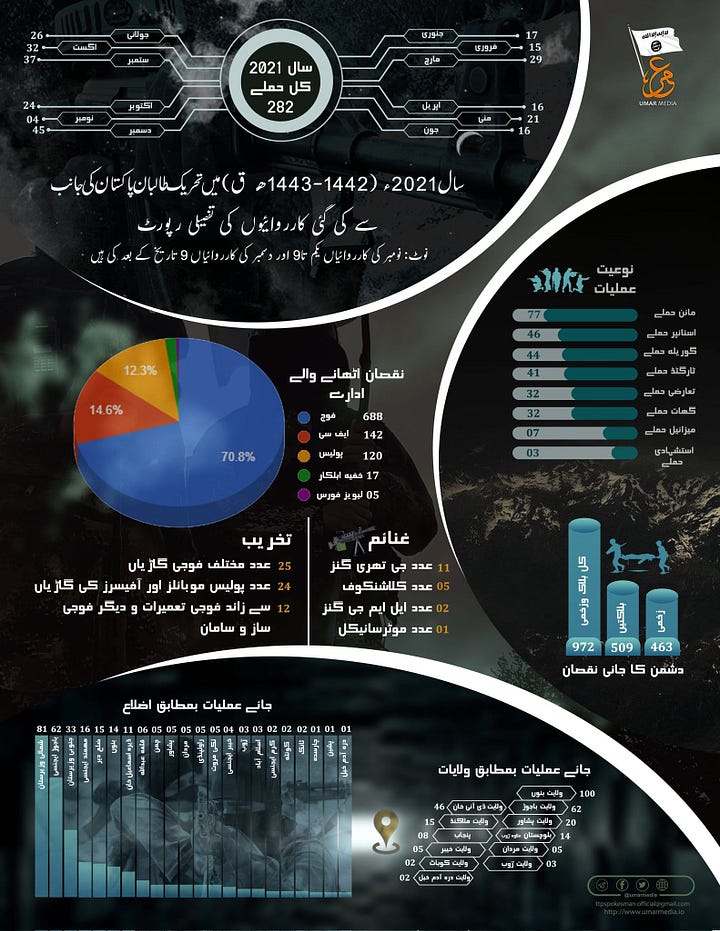
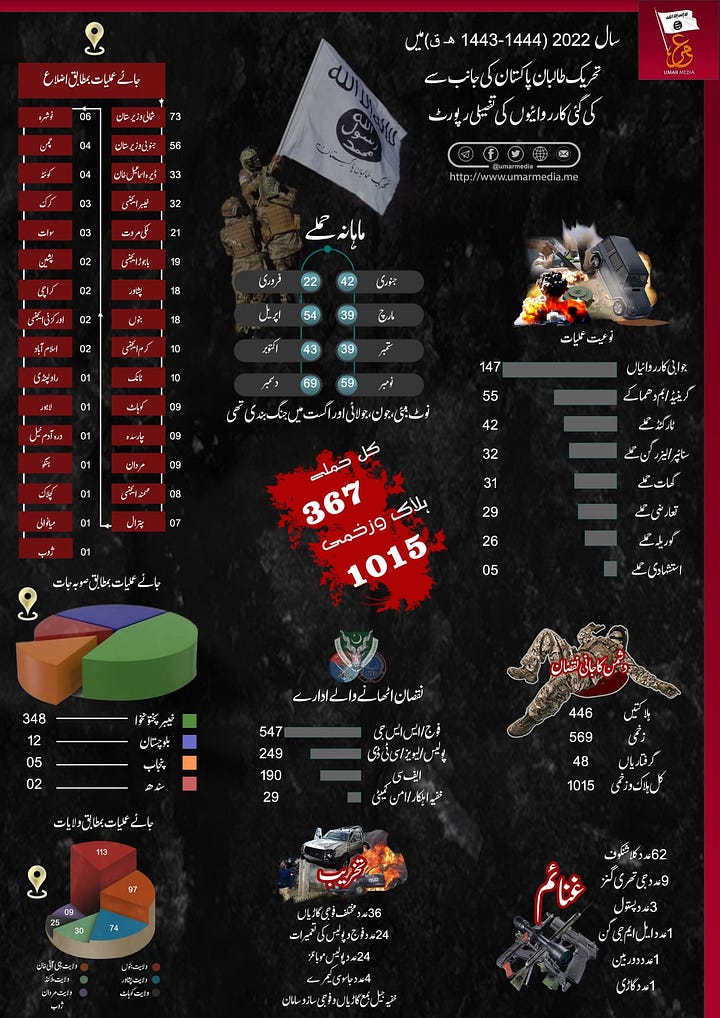
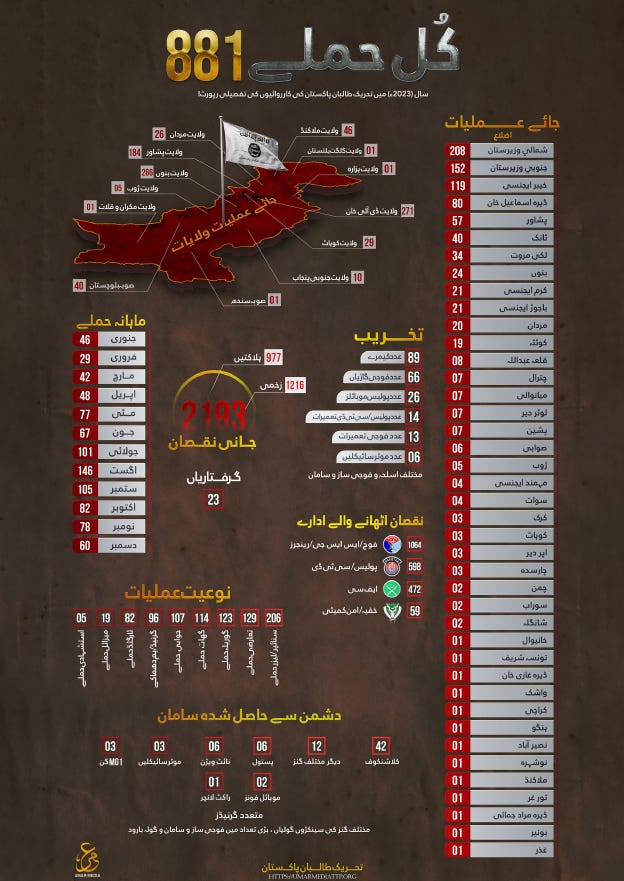
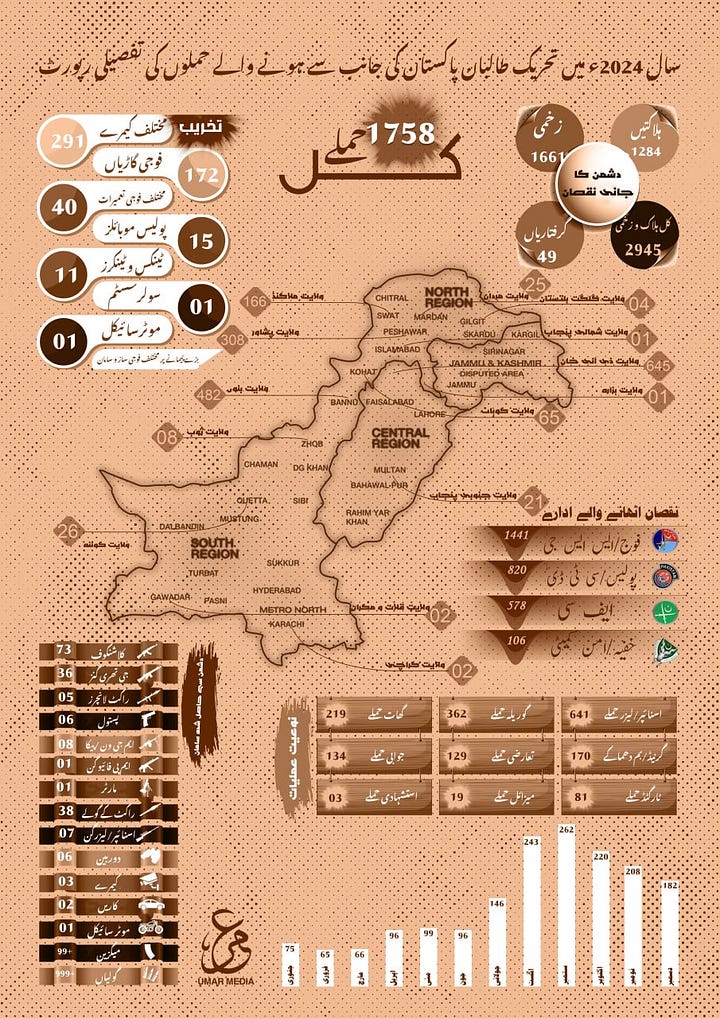
Furthermore, while this is not an entirely new phenomenon, for some Pakistani Taliban factions more than others, the high number of claims is part of a larger design aimed at redefining their image through the articulation of a new structure. Pakistani Taliban have been focusing on improving their power-projection capabilities through the establishment of ever more complex structures that can convey the sense that the militant groups are expanding and increasing their strength. In 2024, for instance, the Hafiz Gul Bahadur group (HGB, or Tehreek-e-Taliban Ghazwatul Hind, TTG), framed a new structure that for the first time signaled that HGB was shifting from a jihadist tribal militia into a local powerhouse following the example of the TTP.
Thus, as the Pakistani Taliban attempt to expand their influence and power of attraction, they inevitably end up competing with each other for recruits and resources. This competition becomes manifest with the mergers of militant groups with the faction that outbids the others. The consequence is a political game between commanders and sub-factions who switch sides for opportunistic reasons or to consolidate their power-base on the local population.
Three major factions have monopolised the militant jihadist landscape in Pakistan: Tehreek-e-Taliban Pakistan (TTP), Hafiz Gul Bahadur group (HGB, or Tehreek-e-Taliban Ghazwatul Hind, TTG), and Tehreek-e-Lashkar-e-Islam Pakistan (TLIP or simply LeI). While focusing solely on these three factions would underestimate the complexity of militant dynamics on the ground, they still represent an indicator of jihadist groups' changing approach to their ultimate politico-military goal. They also address some of the main factors that are affecting the militant scenario of Pakistan.
In the first three weeks of January 2025, the TTP, HGB, and LeI combined claimed more than 120 attacks across Pakistan. The areas of operations of their attacks remain within the trend of the previous year. The TTP claimed the majority of attacks in every province of Pakistan except Islamabad Capital Territory. While the TTP quantity of attacks is following the number of attacks claimed in December 2024 (182), the group has already exceeded the 75 attacks claimed in January 2024.
Similarly, HGB and LeI have both claimed several attacks concentrated in their usual operational areas: Khyber’s Tirah Maidan area for LeI and Bannu, North Waziristan, and even Dera Ismail Khan for HGB.
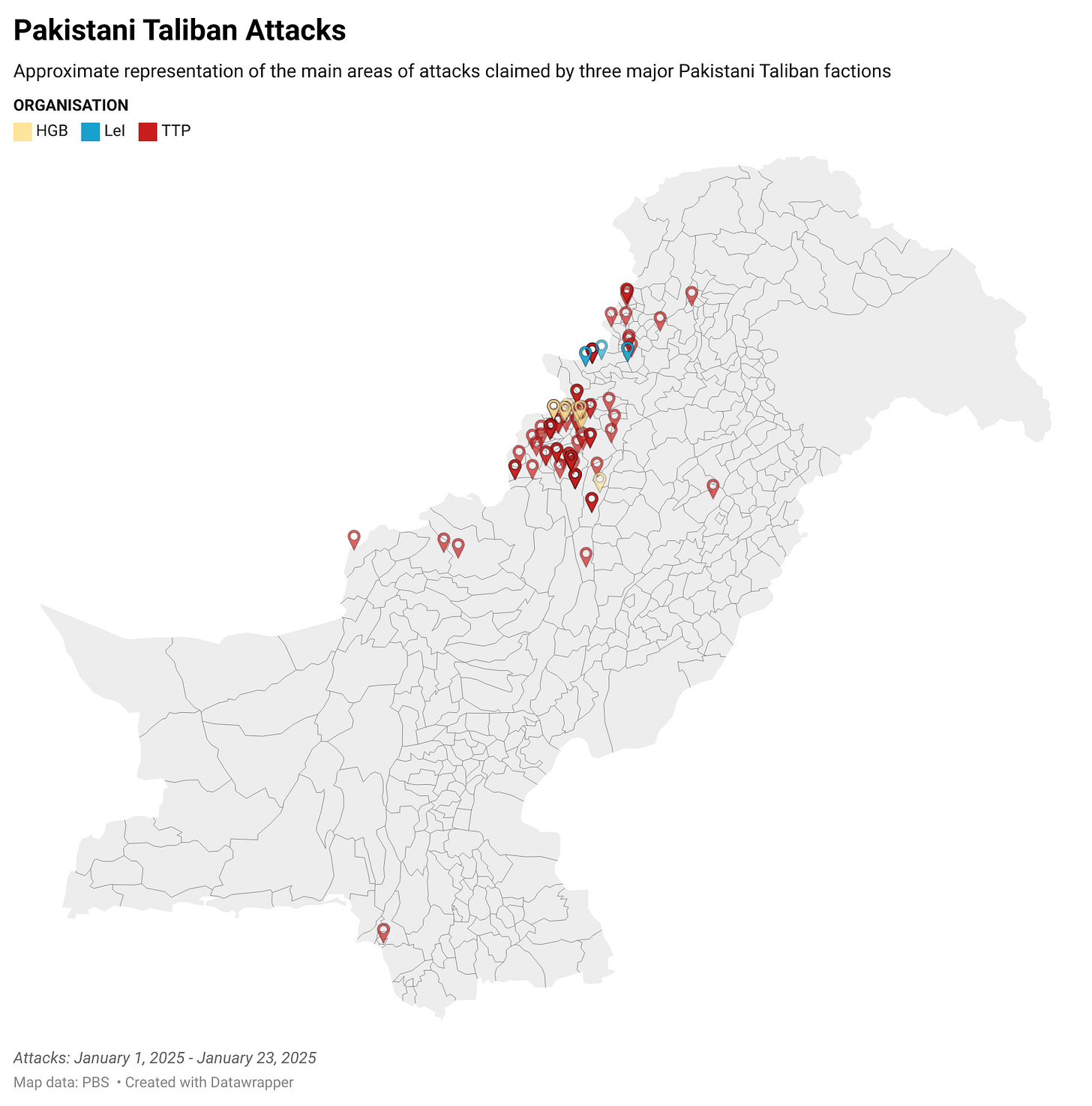
Furthermore, since the start of 2025, the jihadist militant environment in Pakistan has been marked by a series of changes that involve alliances between different Pakistani Taliban factions. In the span of just 19 days, the TTP was able to merge four new groups into its fold, while HGB suffered from the defection of a prominent commander and officially incorporated some commanders already affiliated and reinforced its alliance with an important militant faction.
Between January 14 and 16, the TTP announced that three militant groups from Balochistan Province had joined the group. Located in the Khuzdar and Mastung areas, which fall under the shadow province of Qalat and Makran for the TTP, Shahid Umar Baloch, Mawlawi Shoaib Baloch, and Mawlawi Yasir joined the TTP alongside their companions. Among these, Yasir is said to have several hundred militants, being one of the major groups that joined the TTP from Balochistan.
These mergers followed the defection to the TTP of another militant commander, Ali Dawar aka Alamgir, the supreme commander of the Jaish-e-Omeri (JeO) faction of HGB, on January 12. This marked the first major loss for HGB since 2020 after losing its own deputy, Commander Aleem Khan, who had also joined the TTP. Ali Dawar joined the TTP together with some of his own sub-commanders and militants of JeO; however, since JeO is a special faction of HGB made by militants coming from different groups of HGB, the special unit remains active under the leadership of HGB, who nominated Maulvi Farooq aka Maulvi Shafaq as the new head of JeO. Meanwhile, TTP militants affiliated with Ali Dawar published pictures and videos of the commander head of the suicide bomb squad of Ali Dawar together with suicide bombers carrying the TTP flag.
While militants from both Pakistani Taliban factions repeatedly stated that no enmity is sparked by these mergers, highlighting that TTP and HGB have the same goal, follow the same jihadist path, and differ only in tactics, a competition focused on power projection started between the TTP and HGB.
Between January 13 and 14, a day after Ali Dawar defected to the TTP, HGB announced the official incorporation of another commander into their jihadist platform. Mawlawi Abu Zar Bangash and his group from the Kohat area of Khyber Pakhtunkhwa pledged allegiance to HGB via another prominent commander already affiliated with HGB: Mukhlis Mehsud. Both of them belong to the Hakeemullah Mehsud Karwan group, which pledged allegiance to HGB already in November 2024 via its commanders Mukhlis Mehsud and Zarar, led by Umar Mehsud. Later, on January 22, a commander from Dera Ismail Khan, Iftikhar aka Umar, pledged allegiance to HGB, with the group claiming also attacks in the district in the name of HGB.
While the mergers were important because they further expanded HGB's foothold outside the traditional North Waziristan-Bannu region, they were minor mergers. However, between January 16 and 18, rumors started to circulate among Pakistani Taliban members that HGB was set to announce a major development regarding Lashkar-e-Islam (LeI) on January 18. Shortly after, LeI and HGB announced that the two groups had decided to reinforce their alliance by pledging unity of struggle.
Based in the Khyber tribal district's Tirah Valley, LeI is a powerful group that resurged in recent years, mostly after August 2021 and particularly since 2022. After the killing of its founding leader, Mangal Bagh, in January 2020 in a mysterious blast in Nangarhar Province of Afghanistan, LeI had been led briefly by Zala Khan Akakhel; however, as a prominent commander of the group revealed, due to an illness that struck the latter, Tayyab Afridi aka Ajnabi, one of the sons of Mangal Bagh and previously deputy to Zala Khan, became the new leader of LeI.
LeI has maintained independent leadership while nurturing close relations with both the TTP and HGB, mostly through connections with Jamaatul Ahrar (JuA) commanders and Majlis-e-Askari Karwan's leader, Akhtar Muhammad Khalil. Videos featuring tashkeel (fighting units) of Akhtar Muhammad Khalil and LeI walking in different areas of Tirah Valley in the Khyber tribal district were not uncommon, while occasionally, LeI and JuA militants conducted joint attacks in the same area.
Rumors about LeI and potential merger and/or unity are not new. In late February 2024, following a major crisis within the TTP involving JuA and some sections of the TTP leadership, there was news circulating among Pakistani Taliban circles that HGB, TTP, and LeI were considering forming a consolidated platform. At that time, talks were held between TTP, HGB, LeI, and JuA for 5/6 days allegedly facilitated by Afghan Taliban officials, according to a spokesman for HGB. However, no agreement was reached, mostly due to some reservations that HGB and LeI had concerning the TTP in relation to the murder of JuA founding leader, Omar Khalid Khorasani, for which at that time JuA had accused members of the TTP leadership of being involved. Eventually, the TTP and JuA managed to solve their contrasts, hence practically ending the experiment for creating a unified platform. However, different commanders of HGB, LeI, and JuA repeatedly said to The Khorasan Diary at that time that talks between HGB and LeI were still ongoing, and that the possibility of merging the two was not completely off the table.
Less than a year later, rumors started to circulate again. However, this time, the commanders of HGB and LeI confirmed that the pledge of unity of struggle had been taken. It became official when the spokespersons of the two factions openly acknowledged it.
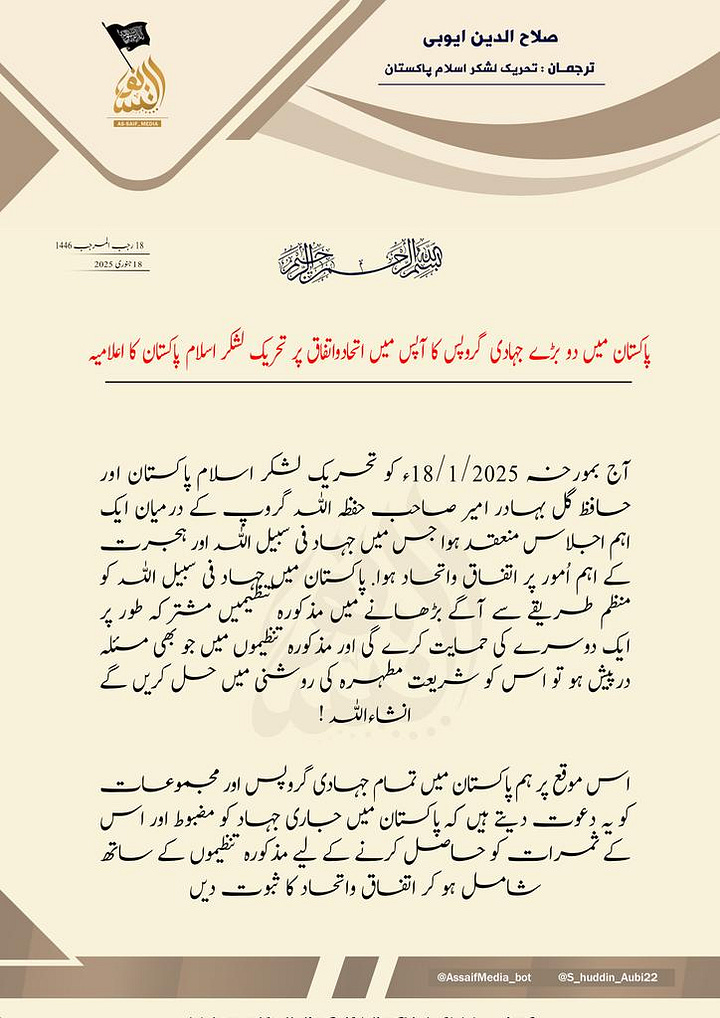
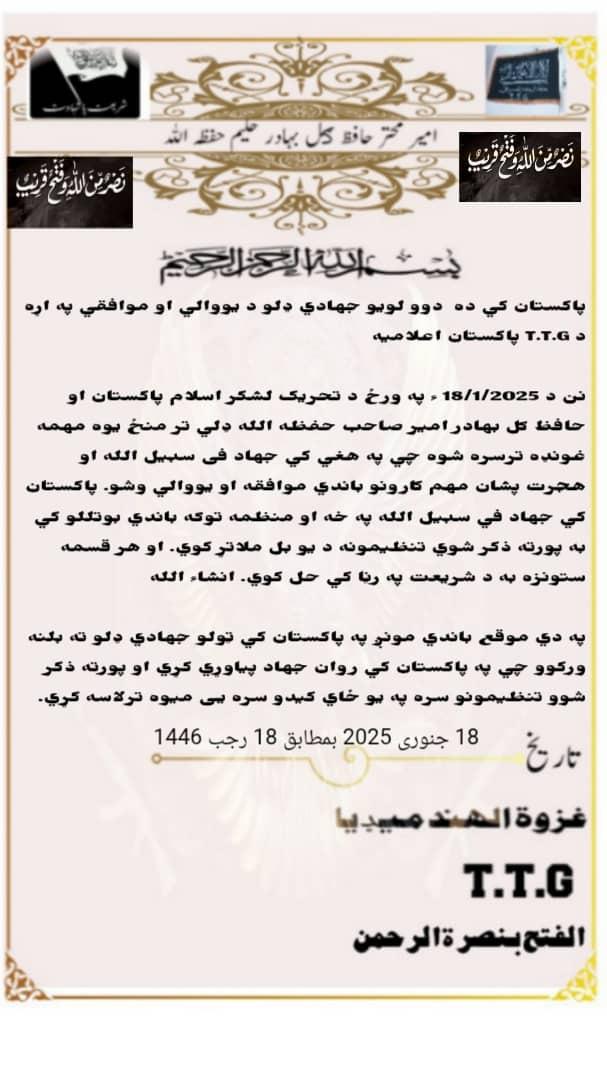
Meanwhile, on January 18, the TTP inaugurated its new structure for the year 2025. An annual practice started in 2022, the structure of the TTP has been increasingly expanding in its multiple articulations. In mid-2022, the TTP displayed a limited number of shadow provinces, first seven and then eight by the end of the year. At the same time, for the first time, it openly revealed the presence of an internal administration divided into different ministries. The structure outlined for 2024 included 11 shadow provinces whose number increased during the year, reaching a total of 14. However, in 2025, the TTP massively expanded its structure by reaching the number of 37 shadow provinces, adding new ones for Balochistan while fragmentation larger provinces into small ones, often matching the actual district-level administration of Khyber Pakhtunkhwa. Additionally, the 2025 chart outlined in detail the administration of every province and every ministry. Furthermore, the TTP inaugurated new committees for overseeing the overall administration of the provinces in addition to the already established commissions for military operations.
For the first time ever, the TTP also disclosed the members of the Rahbari Shura or Leadership Council. Comprising 17 members, it includes senior leaders of the TTP and founders but also prominent commanders and veterans. It also reveals that the TTP opted for a balance of power among factions and institutions in the Leadership Council while reinforcing the grip of the leader of the group, Mufti Noor Wali Mehsud.
All of these changes highlight the fluid characteristics of the composition of the militant landscape in Pakistan. They also underscore how Pakistani Taliban factions have been able - to different degrees - to accommodate both a long-term, ambitious vision and local, warlord-like short-term objectives. This is possibly the deadliest combination for Pakistan’s security environment because it encapsulates local conflicts and grievances into a higher goal. And for now, the Pakistani Taliban seem to have found an effective strategy to streamline both.




That's a very comprehensive report on TTP. Thanks, Riccardo... 👍